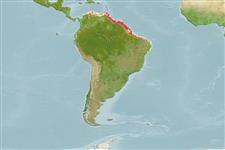Environment: milieu / climate zone / intervalo de profundidade / distribution range
Ecologia
marinhas; Água doce; estuarina demersal. Tropical; 13°N - 11°S, 77°W - 35°W
Western Atlantic: Caribbean and Atlantic draining rivers and estuaries from Colombia to Brazil.
Length at first maturity / Tamanho / Peso / Idade
Maturidade: Lm 36.6 range ? - 44.7 cm
Max length : 100.0 cm TL macho/indeterminado; (Ref. 3265); common length : 50.0 cm TL macho/indeterminado; (Ref. 3265); peso máx. Publicado: 9.0 kg (Ref. 5217); Idade máx. registada: 4 anos (Ref. 51629)
Espinhos dorsais (total) : 1. The head is more or less flattened, the nostril nearly rounded, mouth inferior. There are three pairs of barbels, 1 pair of maxillary barbel and 2 pairs of mandibular barbels.
Body shape (shape guide): elongated.
Inhabits mainly brackish estuaries and lagoons. Occurs also in freshwaters (Ref. 58022). Found on shallow muddy bottoms (Ref. 5217). Feeds on fish and shrimps. Two annual cycles of slower growth occur during the dry seasons (March and August to November). Life span is three to four years. Sexually mature at 1.5 to 2 years of age. Reproduction takes place from November to April. Consumed as food (Ref. 35381). Marketed fresh. The skull is sold throughout the world as crucifix.
Life cycle and mating behavior
Maturidade | Reprodução | Desova | Ovos | Fecundidade | Larvas
Pairing involved in reproduction. Mouth brooding may be employed (Ref. 205).
Taylor, W.R. and N.A. Menezes, 1978. Ariidae. In W. Fischer (ed.) FAO species identification sheets for fishery purposes. West Atlantic (Fishing Area 31). volume 1. [pag. var.]. FAO, Rome. (Ref. 3265)
Categoria na Lista Vermelha da IUCN (Ref. 130435: Version 2025-1)
Ameaça para o homem
Traumatogenic (Ref. 36613)
Utilização humana
Pescarias: espécies comerciais
Ferramentas
Relatórios especiais
Descarregue XML
Fontes da internet
Estimates based on models
Preferred temperature (Ref.
123201): 26.9 - 27.8, mean 27.4 °C (based on 66 cells).
Phylogenetic diversity index (Ref.
82804): PD
50 = 0.5078 [Uniqueness, from 0.5 = low to 2.0 = high].
Bayesian length-weight: a=0.00617 (0.00377 - 0.01008), b=3.17 (3.02 - 3.32), in cm total length, based on LWR estimates for this species & (Sub)family-body (Ref.
93245).
Nível Trófico (Ref.
69278): 4.4 ±0.7 se; based on diet studies.
Resiliência (Ref.
120179): Elevada, tempo mínimo de duplicação da população menor que 15 meses (tm=1.5; tmax=3.5; K=0.5).
Prior r = 0.98, 95% CL = 0.65 - 1.47, Based on 3 data-limited stock assessments.
Fishing Vulnerability (Ref.
59153): High vulnerability (60 of 100).
🛈
Nutrients (Ref.
124155): Calcium = 98.3 [51.2, 205.4] mg/100g; Iron = 1.09 [0.68, 1.92] mg/100g; Protein = 17.3 [15.6, 19.0] %; Omega3 = 0.169 [0.095, 0.304] g/100g; Selenium = 68.5 [33.7, 141.9] μg/100g; VitaminA = 16.1 [6.8, 40.8] μg/100g; Zinc = 0.811 [0.533, 1.257] mg/100g (wet weight);
